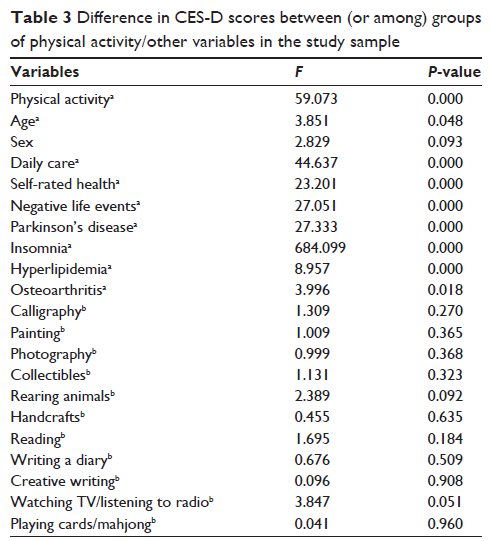108384
论文已发表
注册即可获取德孚的最新动态
IF 收录期刊
- 3.4 Breast Cancer (Dove Med Press)
- 3.2 Clin Epidemiol
- 2.6 Cancer Manag Res
- 2.9 Infect Drug Resist
- 3.7 Clin Interv Aging
- 5.1 Drug Des Dev Ther
- 3.1 Int J Chronic Obstr
- 6.6 Int J Nanomed
- 2.6 Int J Women's Health
- 2.9 Neuropsych Dis Treat
- 2.8 OncoTargets Ther
- 2.0 Patient Prefer Adher
- 2.2 Ther Clin Risk Manag
- 2.5 J Pain Res
- 3.0 Diabet Metab Synd Ob
- 3.2 Psychol Res Behav Ma
- 3.4 Nat Sci Sleep
- 1.8 Pharmgenomics Pers Med
- 2.0 Risk Manag Healthc Policy
- 4.1 J Inflamm Res
- 2.0 Int J Gen Med
- 3.4 J Hepatocell Carcinoma
- 3.0 J Asthma Allergy
- 2.2 Clin Cosmet Investig Dermatol
- 2.4 J Multidiscip Healthc

已发表论文
体力活动成为防止社区里的中国老兵出现抑郁症状的因素结果来自全国范围内的现况研究
Authors Du WJ, Tan JP, Yi F, Zou YM, Gao Y, Zhao YM, Wang LN
Published Date March 2015 Volume 2015:11 Pages 803—813
DOI http://dx.doi.org/10.2147/NDT.S80295
Received 4 January 2015, Accepted 12 February 2015, Published 23 March 2015
Background: Physical activity is generally considered to be effective in reducing
the prevalence of depression and promoting remission of its symptoms. However,
large-scale epidemiological research on this issue is lacking in older Chinese
adults. We performed a nationwide epidemiological survey to determine the
relationship between physical activity and depressive symptoms in older Chinese
veterans in the community, with adjustment for potential confounders.
Methods: A cross-sectional study was conducted in a representative sample of 9,676 community-dwelling older Chinese veterans. Depressive symptoms were identified using the Center for Epidemiological Studies Depression Scale. Physical activity was self-reported using a one-year physical activity questionnaire. Information about covariates was obtained by questionnaire-based interview. Relationships between study variables and symptoms of depression were estimated using unadjusted and adjusted analyses.
Results: The median age was 82.29 (interquartile range 80.25–84.60) years. In total, 81.84% of the study participants engaged in physical activity that was predominantly light in intensity. In unadjusted analyses, physical activity was associated with a significantly decreased likelihood of depressive symptoms (5.43% versus 18.83%, P <0.0001). Multivariate logistic regression with adjustment and controlling for confounders, physical activity was still inversely associated with depressive symptoms and was the only independent protective factor (odds ratio 0.57, 95% confidence interval 0.44–0.72, P <0.0001) among the associated factors in this study. In a univariate general linear model, there was a significant difference in Center for Epidemiological Studies Depression Scale score between subjects participating in active physical activity and those who did not (F =59.07, P <0.0001).
Conclusion: This study found an inverse relationship between physical activity and symptoms of depression in older Chinese veterans in the community. It was also indicated that the antidepressant effect of physical activity probably extended to the oldest-old, and the light-intensity physical activity was probably available for the same protective effect. This information could be used to devise further interventions to prevent or ameliorate symptoms of depression.
Keywords: physical activity, depression, protective factor, older adults, Chinese veteran
Methods: A cross-sectional study was conducted in a representative sample of 9,676 community-dwelling older Chinese veterans. Depressive symptoms were identified using the Center for Epidemiological Studies Depression Scale. Physical activity was self-reported using a one-year physical activity questionnaire. Information about covariates was obtained by questionnaire-based interview. Relationships between study variables and symptoms of depression were estimated using unadjusted and adjusted analyses.
Results: The median age was 82.29 (interquartile range 80.25–84.60) years. In total, 81.84% of the study participants engaged in physical activity that was predominantly light in intensity. In unadjusted analyses, physical activity was associated with a significantly decreased likelihood of depressive symptoms (5.43% versus 18.83%, P <0.0001). Multivariate logistic regression with adjustment and controlling for confounders, physical activity was still inversely associated with depressive symptoms and was the only independent protective factor (odds ratio 0.57, 95% confidence interval 0.44–0.72, P <0.0001) among the associated factors in this study. In a univariate general linear model, there was a significant difference in Center for Epidemiological Studies Depression Scale score between subjects participating in active physical activity and those who did not (F =59.07, P <0.0001).
Conclusion: This study found an inverse relationship between physical activity and symptoms of depression in older Chinese veterans in the community. It was also indicated that the antidepressant effect of physical activity probably extended to the oldest-old, and the light-intensity physical activity was probably available for the same protective effect. This information could be used to devise further interventions to prevent or ameliorate symptoms of depression.
Keywords: physical activity, depression, protective factor, older adults, Chinese veteran
